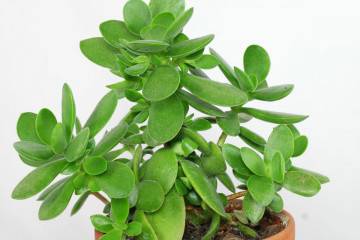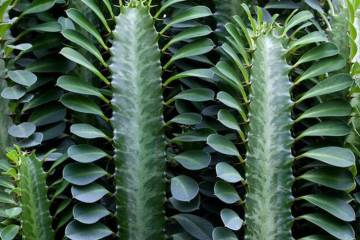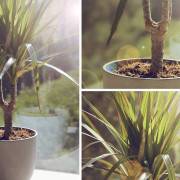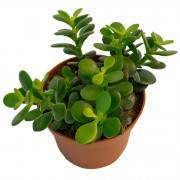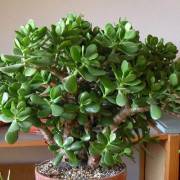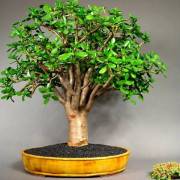Lithops - home care
Content:
Lithops are living stones that are considered representatives of the Aizov family. Succulent plants differ in types, sizes and colors. Ornamental culture is able to adapt to the environment, changing its color and withstanding temperature changes. Specialists in the field of botany count about 37 species of lithops that are found in nature. It is possible to grow only a third of the desert plant species at home.
Description
What are Lithops? Lithops are representatives of a succulent perennial culture, the root system of which is well developed. The volume of roots can be 2-3 times larger than the size of the aboveground part of the culture. The root system is quite tenacious, which allows it to anchor on rocks or a placer of stones. Two small fleshy leaf plates rise above the surface of the soil.
The length of the leaf plates reaches 30-50 mm. The foliage is separated by transverse stripes that slightly diverge to the sides. The color of live stones can be:
- gray;
- green;
- brown;
- purple.
In some cases, there may be a slight pattern or relief of winding lines on the skin. Gradually, the foliage begins to look shriveled and withering. At the same time, young foliage appears from the hollow.
Towards the end of summer, the hollow between the leaf blades expands. A flower emerges from it. The structure of the flowers is reminiscent of cactus flowers. The petals are rather narrow. They are painted in a yellow or white palette. Closer to the central part, the petals begin to converge into a narrow tube. The flowering period lasts about 10-15 days. The diameter of the disclosed flowers can exceed the dimensional characteristics of a living stone.
Varieties
The most popular varieties of lithops that can be grown at home include:
- lithops Aucamp. This succulent was named after a famous biological scientist who was born in South Africa. The upper part of the living stone is rounded. Leaf plates can be painted in green, brown or gray-blue palette. The top of the foliage is covered with colored spots. A deep gap is observed between the lobes of the plant, from which inflorescences of a yellow color range with a weak aroma appear;
- The Optics variety is a type of succulent culture, which is distinguished by the formation of large inflorescences, painted in a white tone. A pleasant, rather delicate aroma emanates from the flowers. A living stone, painted green or gray-green, does not fully fit together. There is a crevice in the central part. It is important to properly care for the Optica variety;
- lithops Pseudotruncatella is an ornamental culture, the leaf plates of which reach 25-30 mm in diameter. The height of the succulent is 4 cm. The foliage is colored in pink, brown and gray shades.The upper part of the leaf plates is covered with graceful ornaments, which consist of dots and lines. During the flowering period, a large yellow inflorescence appears between the share of a living stone;
- olive green variety - a variety of lithops, the height of which is in the range of 20-22 mm. Plant diameter is similar. Matte leaf plates are painted in olive and brown tones. In the upper area of the foliage, there are strokes and specks. During flowering, a large flower appears from the crevice, painted in a yellow palette and resembling a chamomile;
- marble lithops. There are marble patterns on the surface of the leaf plates. Living stones are painted in gray-green tones. The width of the foliage reaches 2 cm. White inflorescences are naturally endowed with large sizes;
- brownish lithops is an amazing decorative culture, the appearance of which resembles stones. Rounded leaf plates are colored brownish brown. There are dots and spots on the top of the leaves. The height of the trunk reaches 3 cm. The yellow inflorescences are large in size;
- keglevid lithops. The succulent leaf plates are quite dense. They are painted in red and brown colors. Lithops flower height does not exceed 25 mm. There are a lot of grooves on the top of the foliage. The diameter of yellow flowers does not exceed 4 cm. Gradually, the culture grows, lateral shoots begin to form;
- lithops Mix is a composition of different types of living stones. When growing a large number of Mix succulents, you can effectively decorate any interior. A variety of leaf plates and patterns add sophistication to the desert plants;
- Soleros variety is a type of succulent that forms several pairs of gray-colored leaf plates. The foliage height reaches 22-25 mm. The diameter is the same. The cleft between a pair of leaflets is not deep enough. The flowers that emerge from the gap are white;
- Pseudo-truncated lithops is a living stone, a very spectacular species of desert plants. The height of the flowers is in the range of 10-30 mm. The leaf plates are painted in a gray, brown and pink palette. In the upper area of the foliage, lines and dots. Flowers of bright yellow color are large in size.
Lithops: home care
Lithops need proper care. Special difficulties are not required, but it is important to pay special attention to the irrigation regime, the level of humidity and the frequency of feeding. Below you can familiarize yourself with the main features of caring for succulents.
Seat selection
Lithops are living stones that belong to the category of light-loving plants. When choosing a zone for placing pots, it is worth giving preference to places well-lit by the sun's rays.
Pot selection
Living stones have a well-developed root system. That is why, when choosing a container for planting, it is worth giving preference to containers with a large volume. Live stones should be planted in groups, as plants can die alone. Even if the succulent survives, flowering will not occur.
Priming
At home, a perennial culture grows on rocky soil, which is able to pass moisture and air. The composition of the soil mixture for planting desert plants should include:
- a small amount of clay;
- crushed parts of bricks;
- coarse river sand;
- leaf humus.
Humidity and temperature
In the warm season, it is recommended to humidify the air around Lithops from a spray bottle. Moderate air temperature will have a positive effect on the growth of decorative culture. What should be the temperature in the room? During the winter months, it should reach 10-14 ° C. In summer, flower pots can be taken outside.
Watering
From an excess of moisture, the plant may die. Moistening of the soil should be moderate, which will make it possible to avoid rotting of the root system. It is advisable to use the bottom irrigation method, preventing moisture from entering the area of the gap between the sheet plates. During the period when the plant reaches a state of dormancy, it is not necessary to water.
Top dressing
Most often, live stones do not need additional fertilizing. However, in cases where the culture has not been transplanted for 24 months, fertilizer should be added to the soil, the content of which contains phosphorus.
Pruning lithops
Pruning of lithops is not required. However, to maintain a decorative appearance, experts recommend cutting off inflorescences that have had time to bloom, and foliage that has already begun to die off.
Lithops care in winter
Lithops enter a dormant period twice a year. The first phase of dormancy begins at the time of the change of leaf plates. A living stone slows down in growth and development, as if it seeks to leave strength in order to be able to form new foliage. The second dormancy phase begins after the desert plant has faded. Rest continues for 3 to 5 weeks.
Both phases occur during the cold season. It is very important to provide the culture with proper care during this period. It is better to refuse irrigation and fertilizing procedures, which will make it possible to reduce the level of load on the root system. Pots with live stones are taken out into a room that is reliably protected from drafts.
Flowering features
During the active growth phase, the decorative culture changes leaf plates. The old shell cracks and a new pair of sheet plates begins to form inside. It is not recommended to tear the shell, as such actions harm the succulent.
At the end of August, buds are laid on living stones. After some time, flowering begins, which pleases the owner for only 9-14 days.
How to breed lithops
Live lithops stones can reproduce in several ways:
- by separating the shoot from the large mother plant (the daughter shoot should be transplanted as soon as possible);
- seeds.
Growing lithops from seeds at home is a rather fascinating process, which is desirable to be carried out in early spring.
Step-by-step process of lithops breeding:
- In a spacious container, a soil mixture is harvested, which includes leaf earth, quartz sand, brick chips, and clay.
- After preparing the substrate, the components are thoroughly mixed. It is advisable to make a drainage layer on the surface of the bottom of the pot. The soil mixture is poured into a container and loosened.
- The seed is soaked in water throughout the day to speed up the germination process. The seeds are sown wet in the ground.
- After the seeds of Lithops have been deepened into the ground, they should not be sprinkled with a layer of earth.
- The container with crops is covered with a layer of film material and taken out into the room, where the temperature reaches 27 ° C.Every day, the film is removed for a couple of minutes in order to ventilate, and the earth, if necessary, is moistened with a spray bottle.
- As soon as the height of the emerging seedlings reaches 10 mm, you should sprinkle the soil mixture with a layer of expanded clay.
Growing problems, diseases and pests
If you follow the recommendations for caring for perennials, you can avoid various problems associated with growing succulents. Below you can find the most common problems that arise with improper care.
- Pulling succulents, which occurs against a background of poor lighting. It is important to move the plant containers to a well-lit area as soon as possible.
- The lack of flowering is possible due to the wrong location for the desert plant pot.
- The defeat of living stones by mealybug, in which the leaf plates are covered with a white bloom. To cope with the pest, you should carry out a couple of procedures for washing the leaves with water and soap dissolved in it. If this does not help, then Actellik processing is required.
- The defeat of the root system by mushroom mosquitoes, leading to the death of the succulent. To remove sciarides (mushroom mosquitoes), you will need to use a raptor. At the same time, the soil is treated with an insecticidal agent, for example, a fly beetle.
Lithops are an exotic crop that will be liked not only by beginners, but also by experienced flower growers. Lithops can be grown from seeds if desired. To see how flowers make their way through living stones, you should follow the recommendations for caring for a succulent. It is also important to make top dressing in a timely manner and water it correctly.











